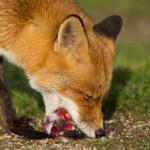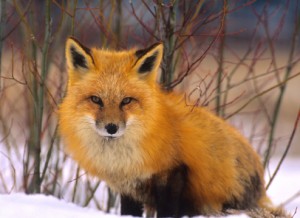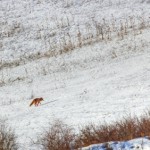Family, Description and Size:
The Red Fox (Vulpes vulpes) is a member of the Carnivora and the largest species of “true foxes”. It has a small build, with delicate limbs and a small snout. Red Foxes have a characteristically bushy long tail and large triangular ears. Their fur color, as their name reveals, is brownish-red with white areas on the stomach and chest. Darker brown or black patches can be seen on the legs and tips of their ears.
On average the Red Fox’s length varies from 18 to 35 inches, it’s height from 14 to 20 inches and it’s weight from 4.9 to 31 lbs with females weighing about 15% less than their male counterparts. Size can vary greatly among the many subspecies of the Red Fox.
Range and Habits:
Red Foxes are arguably the most widespread of the Carnivora species. They exist in the whole northern hemisphere and spread together with human populations. Red Foxes have been introduced to Australia also where it has become a danger to local rare bird and lizard populations.
The Red Fox hunts in packs usually comprised by an adult couple that monopolizes breeding and their offspring that help raise the kits of young. Red Foxes eat small rodents, while also hunting for leporids, game birds, reptiles and invertebrates. Sometimes they feed on fruit and vegetable matter when the need arises.
General Information:
Red Foxes are very widespread as a species and on the least concern list of endangered animals, making them a target for hunters, especially for the fur trade. It is legal to hunt foxes in some areas of the world as long as the hunter gets the appropriate license.
Red Foxes have very good vision, but can mainly detect movement. They use vocalizations to communicate, of which contact calls and interaction calls are the two main categories. Foxes can live in almost all habitats, ranging from urban to forest and from deserts to prairies. They are often targeted by farmers because Red Foxes often prey on young ungulates and poultry whenever the chance arises.
 Red Foxes like to hide carcasses they can’t eat at one go, or have hunted to eat at a later time. They cover these carcasses with leaf and dirt or snow. During times of hunger the fox will remember these hiding places and return there to feed. Once the food storage is depleted they urinate on that spot to remember not to dig there again for stored food.
Red Foxes like to hide carcasses they can’t eat at one go, or have hunted to eat at a later time. They cover these carcasses with leaf and dirt or snow. During times of hunger the fox will remember these hiding places and return there to feed. Once the food storage is depleted they urinate on that spot to remember not to dig there again for stored food.
Predators, Mortality and Lifespan:
The main predators of foxes are usually the larger carnivores living in its territory. Depending on country and habitat these can be wolves, cougars, bobcats, jaguars and generally all large felines. The Red Fox’s greatest enemies though are human hunting, starvation and disease.
The average lifespan of a Red Fox is considered to be only 1 to 4 years, with young hunting on their own as young as 3 months old and reaching adulthood at the age of one year.



